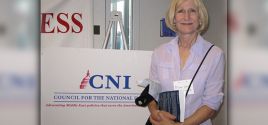Stimulus? Yet Again?Robert P. MurphyMises Institute Sep. 09, 2010 |
Popular 
Netanyahu Cries 'Antisemitism' After International Criminal Court Issues Warrant for His Arrest

Trump Nominates Pam Bondi for Attorney General

Schumer Moves to Silence Criticism of Israel as Hate Speech With 'Antisemitism Awareness Act'

FBI Pays Visit to Pro-Palestine Journalist Alison Weir's Home

Matt Gaetz Withdraws from Consideration as Attorney General
 This week the Obama administration lays out its plans to further "stimulate" the economy. In particular, the president unveiled his proposals for $50 billion more in infrastructure spending, and a $100 billion extension to a tax credit on research and development. Unfortunately these ideas range from misguided to downright harmful. If the federal government really wants to promote economic recovery, it should cut spending and taxes in general, and basically get out of the way. Government Spending and Job Creation As explained in this CNN story, in his Labor Day speech in Milwaukee, "Obama unveiled a $50 billion infrastructure plan to try and create jobs over the long-term by rebuilding 150,000 miles of roads, 4,000 miles of rail, and 150 miles of airport runways." The rationale behind the plan is the simple Keynesian notion that government spending can "fill the gap" in aggregate demand when private businesses and individuals are unwilling to spend enough to keep everyone employed. There are several problems with this common approach. In the first place, it confuses a low unemployment rate with "a healthy economy." Now, it's true that a high unemployment rate goes hand in hand with a sick economy. But the unemployment rate is a symptom of the underlying structural problem. Government efforts to "reduce unemployment" are, at best, like putting ice cubes on a thermometer to treat a fever. For example, most pundits accept the claim that "World War II got us out of the Depression." And it's true that the official unemployment rate dropped like a stone with US entry into the war. But as economic historian Bob Higgs points out, FDR had hardly "fixed" the economy: all he did was force millions of American men to leave the conventional workforce and jump into a slaughterhouse. By the same token, if President Obama made it mandatory for five million Americans to cross the ocean and paint the Great Wall of China, it's possible that the official unemployment rate would drop. Beyond this fundamental confusion, there is another problem with government "stimulus" spending. Simply put, the money has to come from somewhere, and it's not at all obvious that the net result leads to job creation, even if we accept jobs as indicators of a healthy economy. I have written from an Austrian perspective on the problems with government efforts to "create jobs." But even mainstream economists have challenged the Keynesians on their own turf. Using standard econometric techniques, many prominent economists have found little evidence that government spending boosts economic output, even if we accept the standard government figures at face value. Some readers may be surprised to see this, because self-described progressive pundits often claim that only a Neanderthal could possibly doubt the scientific case for government stimulus spending. Yet, as Jim Manzi explained when The New Republic's Jonathan Chait made such a claim, Robert Barro, Professor of Economics at Harvard, John Cochrane, Professor of Finance at the University of Chicago, and Casey Mulligan, Professor of Economics at the University of Chicago, have each separately argued that it is somewhere between plausible and likely that the multiplier for stimulus spending under relevant conditions is indistinguishable from zero (i.e., that stimulative spending will not materially increase economic output). According to surveys of professional economists reported by Greg Mankiw, about 10 percent of economists do not agree with the statement that "Fiscal policy (e.g., tax cut and/or government expenditure increase) has a significant stimulative impact on a less than fully employed economy." Both the Wall Street Journal and the Financial Times have run opinion columns expressing the view that a multiplier of zero is a plausible to likely theory.The context for Manzi's argument with Chait was the embarrassing predicament that Keynesians had gotten themselves into after the first Obama stimulus package. The Obama team had famously predicted that, with the package, unemployment would not break 8 percent — a projection that of course turned out to be rather optimistic. The Keynesian response, of course, has been that the economy was worse than people realized at the start of the Obama presidency. And it's true that we can't prove that the original $800 billion stimulus package made things worse. But my point is, there are plenty of theoretical arguments — both Austrian and mainstream — questioning the Keynesian claims, and recent history suggests a prima facie confirmation of these doubts. To sum up, if the $800 billion stimulus didn't work out as planned, why should we raise the stakes by putting up another $50 billion? Tax-Credit Plan Still a Form of Government Control Even Obama's call for the tax-credit extension leaves much to be desired. I am always for a tax cut, period. It returns resources to the private sector, which I favor for reasons of both ethics and efficiency. However, not all tax cuts are created equal. By giving a tax credit for "research and development" — as opposed to an across-the-board reduction in tax rates — the government is still dictating how businesses use the money that the government refrains from explicitly taking. The difference is analogous to getting $100 in cash versus a nontransferable $100 gift certificate to the Broccoli Warehouse. Most teenagers would opt for the former as a birthday present. Conclusion The Obama administration's newly unveiled plans for "helping" the economy merely attack the symptoms rather than the cause. Yet even on their own terms, the plans are ill-designed to reduce the unemployment rate. The best remedy would be for the government to stop interfering and let the market process work. ____ Robert Murphy is an adjunct scholar of the Mises Institute, where he will be teaching "Principles of Economics" at the Mises Academy this fall. He runs the blog Free Advice and is the author of The Politically Incorrect Guide to Capitalism, the Study Guide to Man, Economy, and State with Power and Market, the Human Action Study Guide, and The Politically Incorrect Guide to the Great Depression and the New Deal. Send him mail. See Robert P. Murphy's article archives. |



